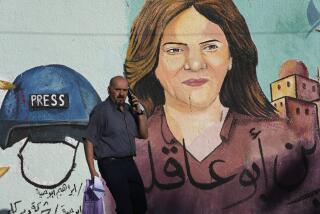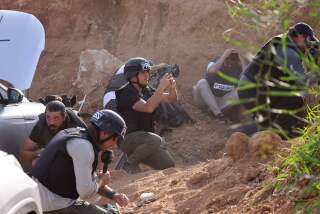A Very Able Disabled Reporter : Radio: Wheelchair-bound NPR reporter John Hockenberry finds his handicap can be an asset in covering a story.
- Share via
JERUSALEM — Covering the Palestinian uprising from a wheelchair, in hilly towns with bumpy alleyways or in cramped refugee camps with sand for streets, was a daunting prospect for radio reporter John Hockenberry, although every once in a while his disability brought a minor advantage.
Sometimes, for instance, Israeli soldiers on guard against intrusive reporters just didn’t bother stopping a guy in a wheelchair.
“It’s shocking how invisible someone in a wheelchair can be. Soldiers just don’t pay attention to you. In a curfew, when no one else is allowed on the street, I could just roll by. It’s unnerving,” he recalls.
Hockenberry has just completed an assignment for National Public Radio as its Jerusalem-based correspondent and returned to the United States to anchor “Heat,” a new talk, interview and satire show that NPR will air five nights a week beginning in March.
His remarkable mobility in difficult conditions made him something of a legend not only among reporters in Israel but among the growing legion of Palestinian wounded and disabled who saw in Hockenberry an inspirational figure on an otherwise bleak future horizon. How, the maimed youth would sometimes ask visiting reporters out of the blue, does this guy in a wheelchair get around like he does?
Hockenberry lost the use of his legs in an auto accident 14 years ago. Once a student of mathematics and music, he describes “stumbling” into journalism first as a free-lance writer for magazines, then on sudden assignment for NPR covering the Mt. St. Helen’s volcano. Shortly after the eruption, he was hired full time by NPR and volunteered for the Middle East in March, 1988. “The uprising was at its height and I had been trying to get the position for the longest time,” Hockenberry says. “So they sent me.”
As for getting around in the rough and tumble of the intifada, as the uprising is called in Arabic, Hockenberry speaks of infinite improvisation--and help from his interview subjects.
“You know how it is in Palestinian villages. There are always a hundred people around to help--carry me up staircases and so on.”
Sometimes, though, the help would evaporate. Once he was working a crowd at the Jabalya refugee camp in the Gaza Strip when suddenly the crowd disappeared. Soldiers had come and lowered their rifles.
“There I was, all alone. It was a spooky situation. They didn’t shoot,” Hockenberry says matter-of-factly.
Hockenberry also covered the Ayatollah Khomeini’s funeral in Tehran last year. He arrived near the city by helicopter and had to rely on a group of mourners to roll him out of a dirt field where he was stuck. One of the Iranians then commandeered an ambulance to ferry him about the fervent crowd of a million at the funeral.
“I kept saying that the ambulance should be used for the mourners. People were fainting all over the place. The Iranians kept saying, ‘No, the ambulance is just for you.’ ”
Hockenberry, 33, spent Christmas in Romania to cover the overthrow of communist dictator Nicolae Ceaucescu. The car trip into the country from Yugoslavia was a fright ride, he says. Edgy militias who manned checkpoints along the way kept fingering their World War I vintage rifles and demanding that he get out of the car; he repeatedly pointed to the wheelchair to explain why he couldn’t comply right away.
A carton of Marlboros to a helpful guide won Hockenberry a safe trip to a Bucharest hotel through the maze of bullets in the Romanian capital.
In Israel, Hockenberry would sometimes seek out Palestinians disabled by bullets and offer friendly advice, even if only by example. Therapy for crippled Palestinians is primitive at best.
“They are left to pray for miracles,” Hockenberry says. “They sacrifice so much and are rotting away.”
He once visited Mokassed, the main Arab hospital in Jerusalem, and came across a paralyzed boy who wanted to know how to get from his chair to the bed.
“I did it myself to show him. He looked hard at what I was doing. Believe me, when you need that kind of information. You are like a sponge. You soak up everything,” he says. “In this job, I learned you can handle just about anything in a wheelchair. Of course, you’re tired at the end of the day.”
More to Read
Sign up for Essential California
The most important California stories and recommendations in your inbox every morning.
You may occasionally receive promotional content from the Los Angeles Times.













